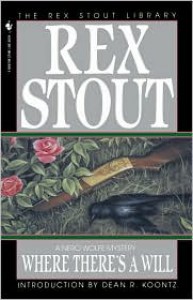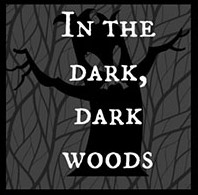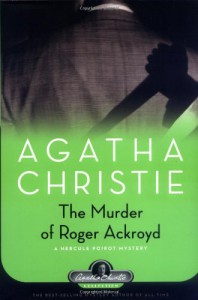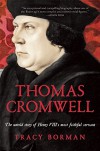SusannaG - Confessions of a Crazy Cat Lady
Just another GR refugee. Other than that, I had a stroke in 2004, and read almost anything I can get my hands on, though I have a particular weakness for history, mystery, and historical fiction.
Currently reading
Halloween Bingo 2018 #1

 Murder Most Foul: Where There's a Will, by Rex Stout.
Murder Most Foul: Where There's a Will, by Rex Stout.
Can anyone explain to me how to make it post a picture of the bingo card, because I can't figure it out? ETA: Solved! Thanks, Themis-Athena.
Where There's a Will

Where there's a will, and also Nero Wolfe, odds are there is also a body or two.
It's 1938, and Nero Wolfe is short on money, so he takes a case he'd rather not: three sisters who want him to investigate the writing of a will. Their late brother promised his sisters a million dollars each, a million to a university, and the residue to his widow. Instead he left most of it to his mistress. (The sisters each received a piece of fruit.) The widow is planning to contest it. To make everything more complicated, one sister is married to the Secretary of State.
Unfortunately, I couldn't like this one as much as many others in the series, as so many of the characters (excluding the residents of the brownstone) are unlikable liars.
 9
9
Reading progress update: I've read 6% of Ice Ghosts

The author has supposedly won a Pulitzer. (OK, it was for photojournalism.)
This book was selected by the Guardian as one of the "best science books" of 2017. The CBC put it at the top of its 2017 "holiday gift guide" of books about science and nature.
I regret to say at 6% in it is poorly organized, opening with three (inadequate) maps (and hard to read on a kindle, though that is not his fault - possibly the publisher's), and a chronology of events which is, depending on how you look at it, either spoilerific or because he couldn't be bothered to write a proper narrative history.
And then the spliced sentences started popping up, as well as at least one sentence fragment. Watson is also addicted to adjectives.
I'll be charitable and say he needed a better and more observant editor. I would think W.W. Norton would have been capable of finding one, but perhaps the experienced ones were all busy elsewhere, and an intern got the job.
(I think - think, mind you - that I shall finish this, as I find the subject fascinating. But his prose style and the freaking sentence splices are getting on my nerves. My fingers are itching for a red pen.)
(US) Sale Alert: Miscellaneous
Both on Amazon, for Kindle:
$1.99: Tourist Season, by Carl Hiaasen. Major Pettigrew's Last Stand, by Helen Simonson.
 4
4
For Shame, GoodReads
As much as I loved to hate "Alaska Liz" and her contrariness - she has just been kicked out of the GR Feedback group, because she told Otis (on his embracing the suggestion that GR needed twitter-style "@person" notification in posts) "In the meantime, you've been doing things to GR's detriment. And you know how much I love this site, I just hate seeing it go down the drain."
Thread: GR "Mention Other Users in Reviews"
For shame, GR, for shame.
2017 in Review
2017 was an excellent reading year around here. I had four five-star reads, not counting re-reads, which is a very high total for me, out of some 90+ books read. One was a novel - 2140 by Kim Stanley Robinson, and three non-fiction: The Invention of Nature, by Andrea Wulf, and two by Ruth Goodman, How to be a Tudor, and How to be a Victorian. Wonderful re-reads included Dorothy L. Sayers' Murder Must Advertise, several Mary Russell novels by Laurie R. King, and The Murder of Roger Ackroyd (which I think I read in about 1978, but remembered nothing).
The best historical novel I read in 2017 was The Summer Before the War, by Helen Simonson, and the best new mystery Racing the Devil, by Charles Todd. I read a decent amount of non-fiction, all of it good, from The Glass Universe (about the ladies of the Harvard Observatory) to Michelangelo's Ceiling (Damn it, your holiness, I'm a sculptor, not a painter), The Sun and the Moon (the Man-bats, or America's first great "fake news" story), and A is for Arsenic (Agatha Christie knew her poisons).
I had some reads that were just pure fun, like Jennifer Crusie's Agnes and the Hitman, Deborah Harkness' trilogy on witches, or Anne Bishop's novels about The Others.
It did have down moments. Calamity in Kent's plot boiled down to "Scotland Yard inspector decides his tabloid journalist friend, Jimmy, is the best choice to solve a locked room mystery, and tells Jimmy to go for it." Um. OK?
The one which angered me, however, was my sole 1-star read of the year, The Ashes of London, which was billed as a thriller set during the Great Fire of London. It is set *after* the fire, did not have very good historical detailing (it could have been pretty much anywhere and anywhen in the past that had suffered a large fire), and had two narrators, neither interesting. And then it offended me with a touch of "let's start the characterization of the woman by having her evil cousin rape her" and I was out.
But most of my reading year was wonderful. I hope yours was, too.
 7
7
The Oregon Trail: An American Journey

This is Rinker Buck's account of how he and his younger brother, Nick, (and Nick's dog, Olive Oyl) traveled the Oregon Trail, from Missouri to Oregon, by covered wagon and mules, in 2011. It hadn't been done since 1909.

Buck seems to have been inspired by a combination of a deep melancholy and a desire to recreate the best summer of his childhood, when his father loaded up all his children (he would eventually have eleven) onto a covered wagon and toured New Jersey and Pennsylvania. Their trip even made the pages of Look magazine as "Covered Wagon Days - 1958." His father hung a sign, reused in 2011, apologizing for the inconvenience, but they wanted their children to "SEE AMERICA SLOWLY."

Rinker was lucky that his brother Nick came along, as Nick is both an expert horseman and apparently can fix anything, both skills much needed on this journey.
Also included are historical accounts of the pioneers and the origins of the Oregon Trail, from George Washington to Brigham Young, and a map, which is not quite as useful as one would hope. Many places are mentioned that aren't marked.
 13
13
How to set your Booklikes 2018 Reading Challenge

To set the reading challenges you're likely seeing post to your dashboard from your followed booklikers, it's at http://booklikes.com/goodies/readingchallenge . If you lose this post/link, it's under "goodies" on the main menu (so is the Reading Challenge widget code for your blog, direct link http://booklikes.com/goodies/widget ).
Click the "read more" if you're in dashboard view and you'd like creenshots (you'll still stay on booklikes without being redirected to another website/blog):
The Sun King Conspiracy

Or, to mangle a title of Rex Stout, Too Many Conspiracies.
Seriously, I lost count of the plots and plot lines; there were too many of both. Unfortunately one of the plots is of the "overarching universal religious conspiracy" variety.
There was also a side of "As You Know, Bob."
I think there was a decent historical novel in here, fighting to get out. But it didn't.
Halloween Bingo Update 6: Written in Red

Written in Red, like the books which follow it, are set in a universe where man is not the dominant predator. Our heroine, in this first one, makes friends with Mr. Erebus Sanguinati - a very powerful vampire.

So I'm using it for Vampires. It would also work for Werewolves, Supernatural, or Monsters.

Read and Called:
Werewolves: Marked in Flesh, by Anne Bishop
In the Dark, Dark Woods: The Virgin in the Ice, by Ellis Peters
Locked Room Mystery: The Murder of Roger Ackroyd, by Agatha Christie
Ghost: The Canterville Ghost, by Oscar Wilde
Read, but Not Called:
Supernatural: Murder of Crows, by Anne Bishop
Vampires: Written in Red, by Anne Bishop
Called, but Not Read:
Genre: Horror
Diverse Voices
Murder Most Foul
Serial Killer
Witches
Cozy Mystery
Haunted House
Off Very Shortly to My Retreat
In about an hour I'm off to Little Switzerland, NC, for a knitting retreat. I'll be bringing mysteries in my bag as well!
Should be back on Sunday. Whether I'm in any condition to post then will be another question!
Halloween Bingo Update 5: The Virgin in the Ice

The Virgin in the Ice is set in the "dark, dark woods." Perhaps not so surprising when it's 1139, there's a civil war on, and Brother Cadfael is on the road to another monastic house (in his capacity as healer).
For the Forest of Cree is full of ice and snow and wind, and murder and mayhem, as well.

It would also work for Amateur Sleuth or Murder Most Foul.

Read and Called:
Werewolves: Marked in Flesh, by Anne Bishop
In the Dark, Dark Woods: The Virgin in the Ice, by Ellis Peters
Locked Room Mystery: The Murder of Roger Ackroyd, by Agatha Christie
Ghost: The Canterville Ghost, by Oscar Wilde
Read, but Uncalled:
Supernatural: Murder of Crows, by Anne Bishop
Called, but Unread:
Genre: Horror
Diverse Voices
Murder Most Foul
Witches
Cozy Mystery
 8
8
Halloween Bingo Update 4: Marked in Flesh

Marked in Flesh, like the rest of the books in this series, has plentiful supernatural characters, but several of the most important are werewolves.

And that's the square I'm using it for. (Would also qualify for Supernatural, Vampires, or Monsters.)

Called and Read:
Werewolves: Marked in Flesh, by Anne Bishop
Locked Room Mystery: The Murder of Roger Ackroyd, by Agatha Christie
Ghost: The Canterville Ghost, by Oscar Wilde
Read, but Uncalled:
Supernatural: Murder of Crows, by Anne Bishop
Called, but Unread:
Genre: Horror
Murder Most Foul
In the Dark, Dark Woods
Witches
Cozy Mystery
 6
6
Halloween Bingo Update 3: Murder of Crows

I really wanted to read this series, and unfortunately it seems my library has roughly every other book in a format I can use. So I started with the second book, Murder of Crows, but I don't think I had too much trouble figuring out what was going on.
Back in the winter, in Written in Red, Meg Corbyn (alias cs759) fled the compound where she, along with many other girls, was held captive, and the man known as the Controller, who ran it. Meg fled on a wild course evading her pursuers, and ended up in the city of Lakehaven, and took the only job she could find - Human Liaison at the city's diplomatic Courtyard. (Humans are not the dominant predators of this universe's Earth; the terra indigenes are. Our folklore refers to some of them as vampires and werewolves. Some of them are much scarier.)
As it turned out, this was the best thing she could have done. For Meg was no normal human - she was a cassandra sangue - a blood prophet. And the terra indigenes were the only ones who might be able to keep her safe.

I read this for Supernatural, but it would also qualify for Monsters, Vampires, or Werewolves.

Called and Read:
Locked Room Mystery: The Murder of Roger Ackroyd, by Agatha Christie
Ghost: The Canterville Ghost, by Oscar Wilde
Read, but Uncalled:
Supernatural: Murder of Crows, by Anne Bishop
Called, but Unread:
Werewolves
Genre: Horror
Murder Most Foul
In the Dark, Dark Woods
Witches
Cozy Mystery
 8
8
Halloween Bingo Update 2: The Murder of Roger Ackroyd

OK, let me write this a second time, and we'll just hope it doesn't get eaten this time!
The Murder of Roger Ackroyd is one of Agatha Christie's best constructed mysteries. It came out in 1926, and is undoubtedly her best mystery of the 1920s. This is technically a re-read for me, but it's been at least 35 years, so the read was not exactly "fresh." I did, however, remember the twist, but that allowed me to admire the skill of the construction.
Our narrator, one Dr. Sheppard, opens our story by discovering that one of his patients has almost certainly committed suicide by an overdose of sleeping pills.
He then attends dinner at the home of the richest man in the village, Roger Ackroyd, and the two have drinks alone after dinner, in Ackroyd's study. Here he learns that she did indeed commit suicide - she was driven to it by the increasing demands of a blackmailer.
After Dr. Sheppard returns home that evening, he receives a strange phone call, and hurries back to Ackroyd's house, where they find Ackroyd has been murdered. But everyone at the house has an alibi! The police are baffled, and Dr. Sheppard's new neighbor is called in to consult.
Who is his neighbor? Hercule Poirot.

I read this to fill in "Locked Room Mystery" (which it most certainly is), but it would also work for Murder Most Foul, Terrifying Women, or Country House Murder. (ETA: Also Terror in a Small Town or Amateur Sleuth.)

Called and Read:
Locked Room Mystery: The Murder of Roger Ackroyd, by Agatha Christie.
Ghost: The Canterville Ghost, by Oscar Wilde.
The Sun and the Moon

One morning in the late summer of 1835, New Yorkers woke up to read in the newspaper that the eminent British astronomer Sir John Herschel was in Capetown, in southern Africa, where he had invented a new type of telescope. He had turned it to look at the moon, and made great discoveries; the moon possessed lakes and volcanoes, bipedal beavers, and man-bats worshiping at temples, among other wonders.
This was, of course, a hoax, but almost everyone in New York, and then a great many people in the United States generally, and many in Europe, believed it. (Hershel complained in a letter to his Aunt Caroline that he had to answer letters in four languages asking about his great discoveries on the moon - he was quite apparently very fed up.)
The great hoax was the brain child of the New York Sun, the first "penny newspaper," which started publication in 1834. Prior to that time, all of New York's papers cost six pennies a copy, and were aimed at the wealthier members of society, focusing their news on shipping reports and the stock market. None of them had anything so ungenteel as a crime beat or police court reporters. And none of them had a huge circulation.
And then there came The Sun. It cost only a penny, which the vast majority of the city's population could afford to buy. It was flacked by newsboys at every corner (something no established paper did). And it already had a large circulation by the middle of 1835, buoyed by its innovation of crime reporting, and its coverage of the spectacular murder trial of a local religious guru, "Father Matthias." It almost immediately started acquiring competitors, most notably James Gordon Bennett's New York Herald.
Bennett was one of the few in the city who immediately smelled a hoax. The others seemed to be Edgar Allan Poe, who thought the Sun had ripped off one of his stories (and he was most indignant about it), and P.T. Barnum, who knew a good con when he saw one. But few others smelled a rat, and The Sun soared in popularity to become the most read newspaper - certainly in the US, and probably on the planet.
The ironic thing is that Herschel was indeed at Capetown at the time - though he had not invented a new type of telescope, and was looking at pretty much everything except the moon!
















 3
3











